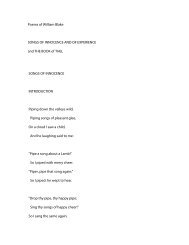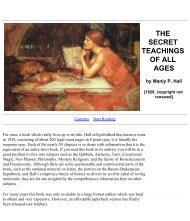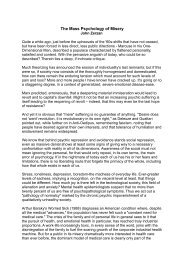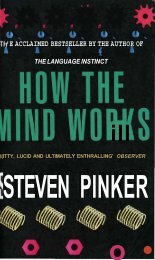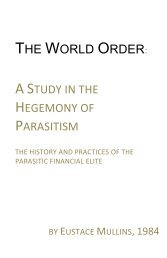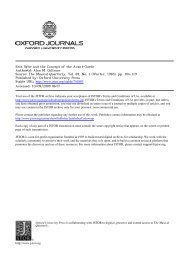The Ever-Present Origin - Michael Goodnight - Editor
The Ever-Present Origin - Michael Goodnight - Editor
The Ever-Present Origin - Michael Goodnight - Editor
- No tags were found...
You also want an ePaper? Increase the reach of your titles
YUMPU automatically turns print PDFs into web optimized ePapers that Google loves.
A note on perspective of presumably later date is illustrative ofLeonardo’scomplete dissociation from the dominantunperspectivalstructure of ancient and early medieval consciousness. In Manuscript G ofthe Institut de France he writes: "In its measurements perspectiveemploys two counterposed pyramids. <strong>The</strong> one has its vertex in the eye [heoften calls the vertex `the point'] and its base on the horizon. <strong>The</strong> secondhas its base resting against the eye and its vertex at the horizon. <strong>The</strong> firstpyramid is the more general perspective since it encompasses alldimensions of an object facing the eye . . . while the second refers to aspecific position . . . and this second perspective results from the first."<strong>The</strong>se remarks express the change from a participation inconsciente towhatwe may call a relation consciente, or conscious relationship. Leonardowas able toplace the vanishing point in space (on the horizon) inopposition.to the passive or"enduring" point of the eye, the receptor of thestream of object impressions, andthus realized the close interrelationshipbetween the two. As he himself notes, "the second pyramid [realizedexternally] results from the first." <strong>The</strong> emphasis has shiftedto the eye ofthe subject — the eye which has realized space and thus established anequilibrium between the ego world (of the eye) and the external world (thehorizon).This Statement of Leonardo's is also a conceptual realization oractualization of perspective —a realization that has determined theWestern image of the world ever since. Perspective has determined andcorresponded to this view to such a degree that even a mere generationafter Leonardo (around 1530), Agrippa of Nettesheim was able to include abrief chapter entitled “De Opticavelperspectiva” in his latework DeIncertitudine et VanitateScientiarum et Artium. <strong>The</strong>re we find the revealingstatement: "It[the art of perspective] shows how deformity can be avoidedin painting." And in PietroAretino'sDialogodellaPittura, written about thesame time in honor of Titian, there is a verse frequently repeated:"Chespessoocchioben san favedertorto," which alludes to the no longercurrent tendency toward a kind of prejudicial kind of seeing that, as theverse notes, "frequently allows even healthy eyes to see falsely."Aretino'sreproach, as well as Agrippa's more pointed remark, both ofwhich characterize the unperspectival world and its mode of expression as"deformity" and "false vision," demonstrate clearly that space had alreadyentered consciousness and become accepted at the outset of thesixteenth century. Having achieved and secured the awareness of space,man in the sixteenth century is overcome by a kind of intoxication with it.This perspectival intoxication with space is clearly evident, for example, inAltdorfer's interiors and in the many depictions of church interiors by theNetherlandic masters that have an almost jubilant expression. It is thisjubilation that silences the voice of those who still attempted to preservethe old attitude toward the world. <strong>The</strong> silencing of objections wasfacilitated to a considerable degree by the fact that Petrarch's experienceof landscape and space, as well as Leonardo's application and theory of23



